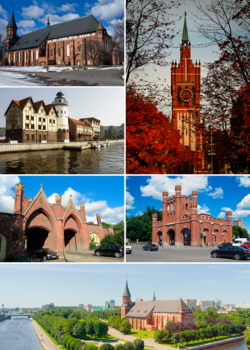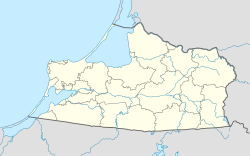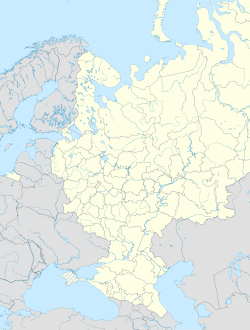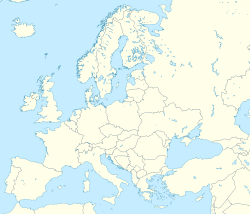Kaliningrad (Russian: Калинингра́д; Lithuanian: Karaliaučius; German: ![]() Königsberg (help·info); Polish: Królewiec; briefly Russified as Russian: Кёнигсберг Kyonigsberg) is a seaport and the administrative center of Kaliningrad Oblast, the Russian exclave between Poland and Lithuania on the Baltic Sea. Kaliningrad is the second-largest city in the Northwestern Federal District, after Saint Petersburg, the third-largest city in the Baltic region and the seventh-largest city on the Baltic Sea. It is the westernmost Oblast of Russia.
Königsberg (help·info); Polish: Królewiec; briefly Russified as Russian: Кёнигсберг Kyonigsberg) is a seaport and the administrative center of Kaliningrad Oblast, the Russian exclave between Poland and Lithuania on the Baltic Sea. Kaliningrad is the second-largest city in the Northwestern Federal District, after Saint Petersburg, the third-largest city in the Baltic region and the seventh-largest city on the Baltic Sea. It is the westernmost Oblast of Russia.
Kaliningrad
Калининград | |
|---|---|
 Church of the Holy Family; Königsberg Cathedral; "Fishermen's village" in pseudo-historic style; Brandenburg Gate; King's Gate; Pregolya River | |
| Anthem: none[1] | |
| Coordinates: 54°42′01″N 20°27′11″E / 54.70028°N 20.45306°E | |
| Country | Russia |
| Federal subject | Kaliningrad Oblast |
| Founded | 1 September 1255[2] |
| Government | |
| • Body | City Council of Deputies[3] |
| • Head[3] | Alexey Silanov[4] |
| Area | |
| • Total | 223.03 km2 (86.11 sq mi) |
| Elevation | 5 m (16 ft) |
| Population | |
| • Total | 431,402 |
| • Estimate (January 2018)[6] | 475,056 |
| • Rank | 40th in 2010 |
| • Density | 1,900/km2 (5,000/sq mi) |
| • Subordinated to | city of oblast significance of Kaliningrad |
| • Capital of | Kaliningrad Oblast, city of oblast significance of Kaliningrad |
| • Urban okrug | Kaliningrad Urban Okrug |
| • Capital of | Kaliningrad Urban Okrug |
| Time zone | UTC+2 (MSK–1 |
| Postal code(s)[8] | 236001 - 236999 |
| Dialing code(s) | +7 4012 |
| OKTMO ID | 27701000001 |
| City Day | 4 July; observed on the first Saturday of July |
| Twin towns | Zeitz, Bremerhaven, Omsk, Brest, Cagliari, Cherbourg-Octeville, Dalian, Yerevan, Forlì, Gomel, Guyuan, Hamburg, Hrodna, Krasnoyarsk, Minsk, Potsdam, Samara, Severodvinsk, Yaroslavl, Baranavichy, Patras, Karlshamn Municipality, Bodenwerder, Kalininsky District, Mühlhausen, Catania |
| Website | www |
It is surrounded by NATO and European Union members Poland and Lithuania and is geographically separated from the main part of Russia itself. Borderless connection is only possible by sea or air.
In 2002, it had a population of 430,003 people. This was more than in 1989, when the last census was done. At that time, the city only had a population of 401,280. About 78% of the people there are Russians, 8% Belarusians, and 7.3% Ukrainians.[9]
Until World War II the people were mostly Germans. Many fled during the war, and the rest were expelled between 1946 and 1949.
It was named Königsberg originally. The city had that name from 1254 to 1945.
History
changeIt was the capital city of the German province of East Prussia, the earlier Duchy of Prussia, and before that of the Monastic State of the Teutonic Knights.
The Albertina University opened in 1544.[10]
Famous people
changeOne of the famous people from Königsberg was the philosopher Immanuel Kant.
References
change- ↑ Article 6 of the Charter of Kaliningrad states that the city may have an anthem, providing one is officially adopted. As of 2015[update], an anthem is not listed among the symbols of the city shown on the official website of Kaliningrad.
- ↑ 2.0 2.1 Official website of Kaliningrad. Passport of Kaliningrad Urban Okrug. (in Russian)
- ↑ 3.0 3.1 Charter of Kaliningrad, Article 25
- ↑ Official website of Kaliningrad. Head of the City, Alexander Georgiyevich Yaroshuk. (in Russian)
- ↑ Всероссийская перепись населения 2010 года. Том 1 [2010 All-Russian Population Census, vol. 1]. Всероссийская перепись населения 2010 года (2010 All-Russia Population Census) (in Russian). Federal State Statistics Service. 2011. Retrieved June 29, 2012.
- ↑ Kaliningrad Oblast Territorial Branch of the Federal State Statistics Service. Оценка численности населения Калининградской области по состоянию на 1 января 2018 года (in Russian)
- ↑ "Об исчислении времени". Официальный интернет-портал правовой информации (in Russian). 3 June 2011. Retrieved 19 January 2019.
- ↑ Почта России. Информационно-вычислительный центр ОАСУ РПО. (Russian Post). Поиск объектов почтовой связи (Postal Objects Search) (in Russian)
- ↑ Kaliningrad Oblast
- ↑ Maria Olerud. https://www.aftenposten.no/historie/i/v5jKpB/stedet-har-en-helt-spesiell-historie-naa-gjoer-byen-baade-russland-og-na. Aftenposten. Retrieved 15 April 2022





